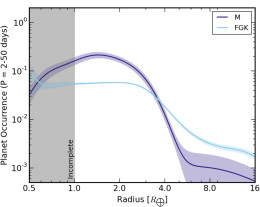In an effort to learn more about how planets form around their host stars, a team of scientists has analyzed the population of Kepler-discovered exoplanet candidates, looking for trends in where they’re found.
Planetary Occurrence
Since its launch in 2009, Kepler has found thousands of candidate exoplanets around a variety of star types. Especially intriguing is the large population of “super-Earths” and “mini-Neptunes” — planets with masses between that of Earth and Neptune — that have short orbital periods. How did they come to exist so close to their host star? Did they form in situ, or migrate inwards, or some combination of both processes?
To constrain these formation mechanisms, a team of scientists led by Gijs Mulders (University of Arizona and NASA’s NExSS coalition) analyzed the population of Kepler planet candidates that have orbital periods between 2 and 50 days.
Mulders and collaborators used statistical reconstructions to find the average number of planets, within this orbital range, around each star in the Kepler field. They then determined how this planet occurrence rate changed for different spectral types — and therefore the masses — of the host stars: do low-mass M-dwarf stars host more or fewer planets than higher-mass, main-sequence F, G, or K stars?
Challenging Models

Authors’ estimates for the occurrence rate for short-period planets of different radii around M-dwarfs (purple) and around F, G, and K-type stars (blue). [Mulders et al. 2015]
Could it be that M dwarfs have a lower total mass of planets, but that mass is distributed into more, smaller planets? Apparently not: the authors show that the mass of heavy elements trapped in short-orbital-period planets is higher for M dwarfs than for the larger F, G and K stars.
All of this goes contrary to expectation, because we know that protostellar disks, from which planets form, are more massive around larger-mass stars. So why is there more heavy-element mass trapped in planetary systems with low stellar mass?
This outcome isn’t predicted by either in situ or migration planet formation theories. The authors instead propose that the distribution could be explained if the inward drift of planetary building blocks — either dust grains or protoplanets — turns out to be more efficient around lower-mass stars.
Citation
Gijs D. Mulders et al 2015 ApJ 814 130. doi:10.1088/0004-637X/814/2/130
